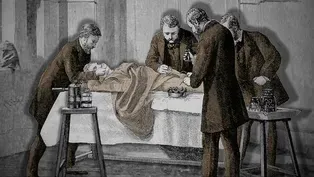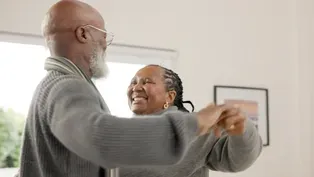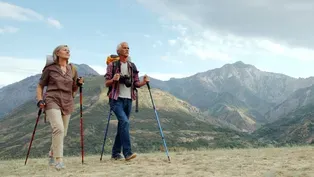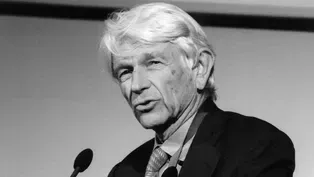
Healthcare
Clip: 5/1/2025 | 2m 58sVideo has Closed Captions
The current healthcare system was not designed to needs of a rapidly aging population.
The current healthcare system was designed to better serve the acute care needs of the young rather than the complex and chronic needs of an older population. This is reflected in the fact there are approximately 60,000 pediatricians in the U.S., but only about 7000 geriatricians. However, innovative solutions like an “age-friendly” emergency department at UC San Francisco are being developed.
Problems with Closed Captions? Closed Captioning Feedback
Problems with Closed Captions? Closed Captioning Feedback

Healthcare
Clip: 5/1/2025 | 2m 58sVideo has Closed Captions
The current healthcare system was designed to better serve the acute care needs of the young rather than the complex and chronic needs of an older population. This is reflected in the fact there are approximately 60,000 pediatricians in the U.S., but only about 7000 geriatricians. However, innovative solutions like an “age-friendly” emergency department at UC San Francisco are being developed.
Problems with Closed Captions? Closed Captioning Feedback
How to Watch Aging in America: Survive or Thrive
Aging in America: Survive or Thrive is available to stream on pbs.org and the free PBS App, available on iPhone, Apple TV, Android TV, Android smartphones, Amazon Fire TV, Amazon Fire Tablet, Roku, Samsung Smart TV, and Vizio.
Providing Support for PBS.org
Learn Moreabout PBS online sponsorshipMARTIN: The problem for older people is that America's healthcare system was designed for the acute care needs of the young, rather than the often more complex chronic diseases of older adults.
♪ DR. CASSEL: Back in the '70s, there was no specialty of geriatric medicine.
One of the main influences for me was reading Robert Butler's book, "Why Survive?"
It was one of the few places that really pulled together, kind of what I was seeing as a young physician and did it in a very compelling way.
MARTIN: In 1982, Dr. Butler founded the first department of Geriatrics in a U.S. medical school at Mount Sinai in New York City.
DR. CASSEL: Sadly, the field of geriatrics has never really taken off the way Bob Butler envisioned that it would and many of us hoped that it would.
DR. WALTER: There's less than 7,000 geriatricians in the U.S. right now.
I mean, contrast that with over 60,000 pediatricians, you know, it doesn't match up with the whole population aging.
Our health systems have not prepared for an aging population and the issues that come along.
MARTIN: The division of geriatrics at the University of California at San Francisco has developed innovative approaches to address these challenges.
DR. WALTER: We currently do not have enough geriatricians to take care of all the older people in this country, right?
So we absolutely have to train other disciplines and specialties the basic principles of geriatrics.
DR. CASSEL: What's really needed is an interdisciplinary team, we need nursing, we need social work, we need pharmacy, we need occupational and physical therapy.
And together, that can really form a much more effective and cost-effective team.
MARTIN: One of UCSF's innovations is an emergency department that is expressly designed to serve older patients.
DR. WALTER: So in terms of the geriatrics emergency department, we actually call it, our age-friendly emergency department.
And how it works is, well again, it was because people would come in, especially folks who have dementia or have other complex medical illnesses, and they were not getting the care they needed in the emergency department.
DR. DEGESYS: An age-friendly emergency department is a state of mind, not a place.
If you think about coming to an emergency department, nobody likes being there, nobody wants to be there.
It's really somebody's worst day.
You need help getting him on the bed.
And it's even harder for older adults who have impairments with hearing or vision, or they don't have their caregiver with them.
We'll help you, we'll help you.
What makes age-friendly emergency departments different is that they have distinct protocols and policies to care for these vulnerable patients in a completely different way.
Video has Closed Captions
Clip: 5/1/2025 | 1m 44s | This animated sequence illustrates the dramatic increase in longevity throughout history. (1m 44s)
Video has Closed Captions
Clip: 5/1/2025 | 2m 40s | The gift of longevity is to be celebrated as many find new purpose in their later years. (2m 40s)
Video has Closed Captions
Preview: 5/1/2025 | 30s | Aging in America: Survive or Thrive is a one-hour documentary narrated by Martin Sheen. (30s)
Video has Closed Captions
Clip: 5/1/2025 | 2m 17s | Dr. Robert N. Butler was a pioneer and visionary who changed our perception of aging. (2m 17s)
Providing Support for PBS.org
Learn Moreabout PBS online sponsorshipSupport for PBS provided by:















